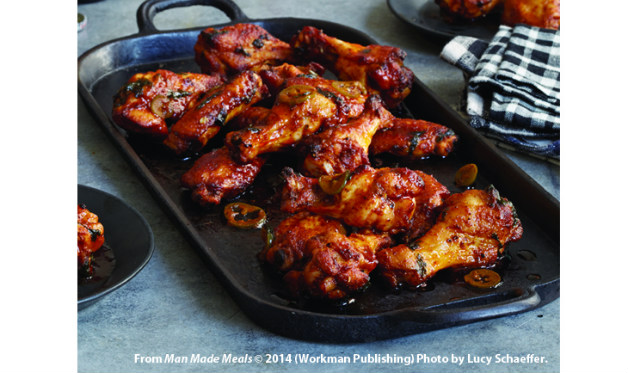Chicken
Grilling Chicken Wings 101: The Ultimate Guide

Americans consume more than one billion chicken wings a year with the average serving being 16 wings. (During the final year of Philadelphia’s famous “Wingfest,” always held the Friday before Super Bowl Sunday, 2019 contest winner Molly Schuyler ate a jaw-dropping 501 wings in one sitting. We’re trying to imagine that pile of bones.)
Right now, air-fried chicken wings seem to be getting all the love. Not from us: We prefer judiciously-seasoned wings cooked to crisp perfection on a grill (preferably over live fire), moist and tender on the inside, perfumed with wood smoke, and either lightly sauced, or even unsauced.
Here are several methods you should know:
Grilled Chicken
Rotisserie/Spit-Roasting: Many gas and charcoal grills include rotisserie set-ups or offer them as an after-market item. Although it’s possible to thread large chicken wings on the spit, a rotisserie basket is very helpful. As the wings tumble, inches over the heat, they self-baste, crisping the skin and keeping them moist. Lacking a rotisserie, skewer the wings on metal or bamboo skewers, turning them frequently over direct or indirect heat. (Oil the skewers well before loading them with the wings.) You can skewer the flats and drumettes separately, or stretch out whole chicken wings on skewers Asian-style.

Indirect Grilling/Smoke-Roasting: This is, perhaps, or favorite method for wings. Set up your grill for indirect grilling by positioning two piles of lit/mature coals on opposite sides of the grill pan, leaving the center coal-free. (We like to put a disposable foil drip pan between the two piles of coals.) Brush or scrape the grill grate clean, and oil it well to prevent the wings from sticking. Arrange the wings in the center of the grill grate in a single layer, then add a handful of soaked and drained wood chips to each pile of coals. Aim for medium heat, about 350 to 375 degrees. Replace the grill lid. Smoke-roast the wings, turning after 15 or 20 minutes. Continue to cook until the wings are done, another 15 minutes or more. (Cut a wing open to check for doneness, or use a meat thermometer with a thin probe to determine if the internal temperature in the meatiest part of the wing has reached 165 degrees. Do not be alarmed if there is a pinkish hue near the bone; this is likely a smoke ring.)
Direct Grilling: This is the most labor-intensive method, requiring nearly constant supervision from the grill master to avoid flare-ups or charred chicken skin. But it can be done! Set up your grill for direct grilling leaving a zone coal-free zone (we call this the safety zone). Brush and oil the grill grate well; oil the chicken, too, as it has a tendency to stick. To make turning the wings more efficient, skewer them as seen above. Soaked wood chips are optional; you’ll need about 1 ½ cups. Again, aim for medium heat (350 to 375 degrees). Turn the skewers often. Remove the wings from the grill, carefully unskewer them, and sauce, if desired.

Here are additional tips for wing success:
- Do not brine the wings before grilling or they will steam rather than roast. Soggy skin can be the result.
- Speaking of skin, be sure to finish your wings at a temperature of at least 350 degrees for the crispiest skin. (If grilling indirectly, finish the wings directly over the coals, watching carefully.) Wings roasted from start to finish at traditional smoking temperatures will yield flaccid, chewy skin.
- If saucing your wings, wait until the last 10 minutes of cooking time or any sugars in the sauce may scorch. Alternatively, toss the wings in sauce after you remove them from the grill.
- Wings have gone up substantially in price during the past year. Buy wings when they’re on sale and store them in your freezer until needed (for up to 6 months). Save additional money buy buying whole wings and cutting them yourself through the joints. (A good chef’s knife [LINK] works well for this.) Some people discard the wing tips; we save ours for stock.
- Get creative! Wings are tremendously versatile. Use different combinations of rubs and sauces—and be sure to record your successes so they can be replicated.
- For extra-crispy wings, add a tablespoon of cornstarch to your rub before coating the chicken. Resting (uncovered) on a wire rack in the refrigerator for up to 4 hours will also promote crispiness.
In the meantime, here are a few of our favorite wing recipes:
Grilled Chicken Wings Recipes
Head over to the BBQ500 club on Facebook. We have an amazing community!
Also, sign up for our Up in Smoke newsletter so you don’t miss any blogs and receive some special offers! PLUS get Raichlen’s Burgers! PDF for free!
Follow Steven on Facebook, Twitter, Reddit, Instagram, and TikTok!




